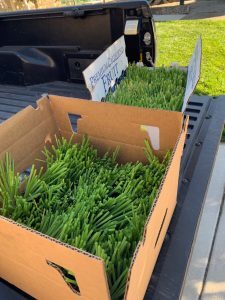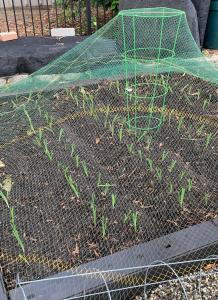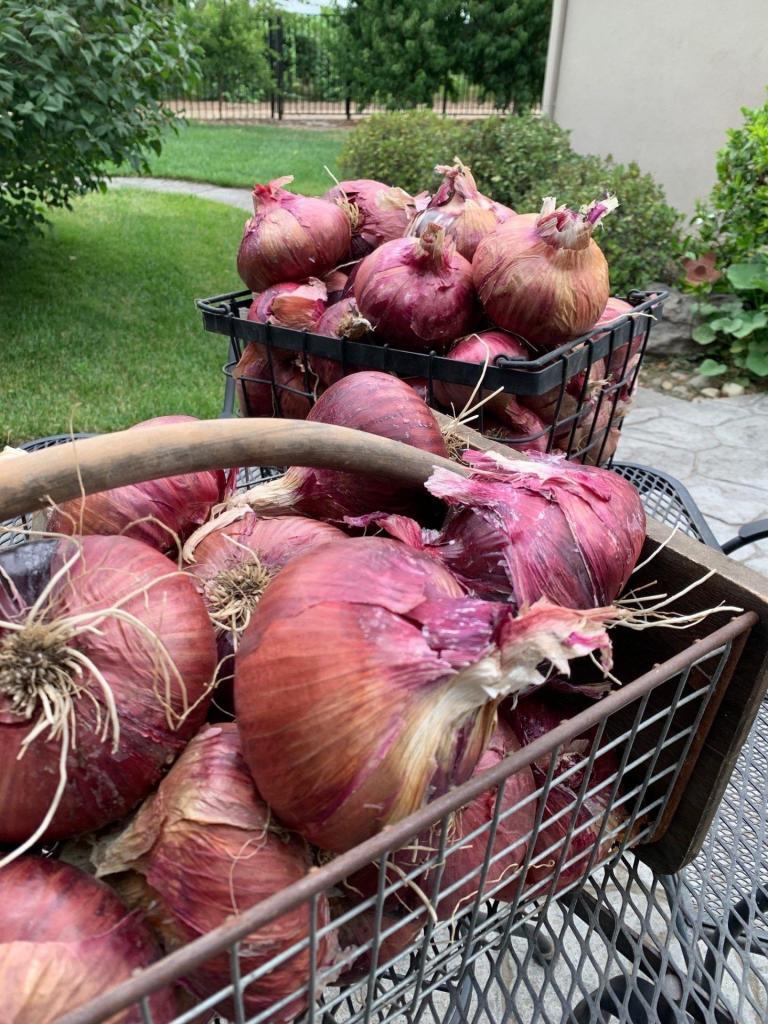Have you ever considered learning how to grow your own onions? These vegetables that have the power to make people cry are easy to grow, easy to store, and easy to use in the kitchen. That is a lot of easy! Of course, there are many health benefits. After all, they are vegetables. You need to eat your vegetables!
Learning about Onions
One thing about onions is that they do take a long time to get to a good harvestable size, and they will take up space in your garden for a long time. I plant them in November and tend to start harvesting them in May or June. If you’re short on space, this can be sort of annoying. When you are ready to put your tomatoes in the ground, you still have these onions taking up space. Just remember this and plan ahead for it. The wait is well worth it. Read on to learn how to grow your own onions.

Onions are classified by the number of hours of daylight required for the plant to grow bulbs – the part of the plant that is the onion. Short day onions begin to develop bulbs when the day length increases to a length of 10 to 12 hours, and long-day onions require 14 to 16 hours of sunlight to grow bulbs. Of course, there are intermediate day and “day neutral” types too.
Most onions grown in North America are long day onions. If you are getting your onion supplies locally, this shouldn’t be a problem, but beware if you are purchasing them online, as things will get all messed up if you grow the wrong type in your area.
One more detail: there are different options in which to start your onions, and I have tried most of the options. One way is to start them by seed. You plant seeds ¼-½ inch deep in loose soil in late-summer. Another way is to plant “sets” which basically look like miniature onions about the size of walnuts. To plant these, you place them in the soil with the tip of the bulb at the surface.
Transplants are my favorite approach. These are little onion plants that have been grown from seed at a nursery. Transplants are planted approximately 1-inch deep and after a few weeks of adjusting will take off quickly. By far my best success has come from transplants. It probably helps that one of the largest transplant suppliers in the state is two miles from my house! Central Valley Transplants in Acampo, California sells to farmers, nurseries, and even homeowners.
My favorite type of onion to grow is the Early Red Burger. The Burger is an intermediate day variety that takes 172 days to mature. I use these in everything from eggs to salads, burritos, and soup. They have mild onion flavor and are also on the sweet side. I also commonly grow the yellow Merlin 1122 onion and long day torpedo onion (long and skinny) and even whites. When you purchase transplants at a supplier they are extremely inexpensive; the price depending on the quantity you purchase. I commonly plant between 100 and 200 onion transplants a year. This will fill 1-2 garden beds.
Onion Planting Process
Onions are best planted in the fall in the Central Valley of California. Fall planting is an excellent time as pest pressure is low and temperatures are not typically hot, allowing less watering. Plus, I don’t sweat buckets of water when I am working on the garden. It goes without saying that you need adequate sunlight and nutrient rich soil to grow onions. I don’t think they are persnickety about soil, however. What I do is dedicate approximately one eight feet ×eight feet (2.44 m) raised garden bed each year. (make sure you rotate locations to avoid disease).
It never hurts to fortify your soil with manure and compost before planting. I make rows and plant my onions on top of rows, between four inches (ca. 10 cm) and six inches (ca. 15 cm) apart. Rows are really helpful as they will help you get through rainy periods by draining water from the roots, avoiding rot. I also use the rows to deep water the onions as they mature in the early summer.
To plant my transplants, I grab a handful of them and trim them off about six inches (ca. 15 cm) from the bottom, so they have fresh cuts. I plant them about one or 1 1/2 inches into the soil. I use my finger to drive them in. The soil should be nice and soft at this point, and the roots head down with my finger.
I generally plant them about four inches (ca. 10 cm) apart. I probably plant them too closely. You could go six inches (ca. 15 cm) apart to give them more room. What I do is plant them fairly close, and then harvest every other onion as they get larger. I also eat the greens in salads or as garnish before some onion bulbs mature. You can harvest the greens almost anytime.

Caring for your Onions
After I plant, I water them well, soaking the soil thoroughly. From here on you will want to make sure that the soil is always moist but not too wet. A week or two after planting, I apply an organic fertilizer. A month or two after that first fertilizer application, I fertilize again with organic fertilizer. To water my onions, I just sprinkle them in the morning and give them a good soaking about 2 to 3 days a week.
Once the roots get bigger and the onion bulbs develop, I will flood the rows to water them. When early summer comes, your onions will be impressively large – several feet high with bright green leaves and bulbs quickly gaining in size at the base near the ground.
One thing that can get annoying is bolting. This occurs when the onion plant starts to flower. It will send up a single round stem that develops a seed bearing flower at the end. If you want to harvest seeds this is one way to do it, however, the onion bulb will stop growing and lose flavor when this happens.
Bolting onions should be harvested as soon as you see the bolting, and they should be eaten as soon as possible as they don’t save well. Some years I get little bolting. Maybe just a few. Other years, I get 10–20 bolts. I think weather has something to do with it. Also, my yellows and whites bolt more than my reds. Another reason why I like reds.
A few things about pests. I have these annoying little birds that run all over the place during the fall, and they will destroy my onions if I don’t cover them with netting. I use bird netting for the first month or two to get the onions off to a good start. Other pest problems I’ve had included gophers. These are super annoying. They will eat the roots and then start eating into the onion. These pests can cause some serious damage, so the gophers must be controlled quickly. I avoid poison and use something called the Gopher Hawk.

During early summer, you will notice the bulbs forming. You can start harvesting any time. I like to wait until they are about baseball size. To harvest, I use a garden fork and drive that fork under and just turn up in the soil and pull them out. They are great to eat fresh, and also it’s recommended if you want to store them for a longer amount of time to put them in the shade in a dry environment for several weeks. I will put them underneath my fruit trees, and sort of raise them up with a screen, so that they can breathe and get air circulation.
After several weeks, the green leaves will die back, and you can pretty much just pull off the leaves that are now turned brown. I tend to cut the roots before I bring them to the house, as they will carry a lot of dirt with them. If cured properly, they will last for months. I will often have them sitting by the back door in the shade between June and October and just eat them as needed.
I also save some by curing them, then putting them in the refrigerator wrapped individually in aluminum foil. They tend to last months in this situation. I’ve also frozen them however, I feel that freezing them is sort of difficult because they get watery. One year I borrowed a dehydrator and saved bags and bags of dried onions.
If you grow a lot of onions like me, you’re going to have several hundred pounds of onions ready to be harvested in May or June. I harvest 20 pounds (ca. 9 kg) or 30 pounds (ca. 14 kg) at a time and just put them on the back porch and whenever someone comes to my house, they get some onions. Some people just absolutely love onions, and you can give a bunch to them. Others you might need to hide them in your bags of produce you give them.
Be sure to share so that people think you’re some sort of master at growing them. But really, they don’t take much effort. They’re super easy, but nobody needs to know that. And then also you can share your transplants because after all they’re one or two cents each, so people think you’re being really generous, but really you’re only sharing $.25 worth of onions. One last thing. I love giving garden tours to kids. They have no idea what an onion looks like. Don’t miss out on that!
Learning More about How to Grow Your Own Onions
To learn more about vegetable gardening, my best suggestion would be to purchase my book, Backyard Big: Growing Food in your Backyard. I address onions and many vegetables, along with many other vegetables. I also include a month-by-month schedule to help the gardener with timing. If you are looking for web sites, Bonnie Plants has a good onion growing site.

